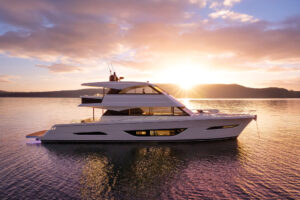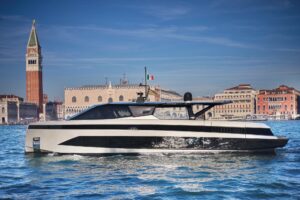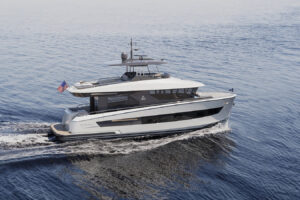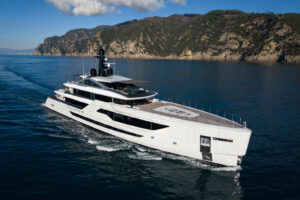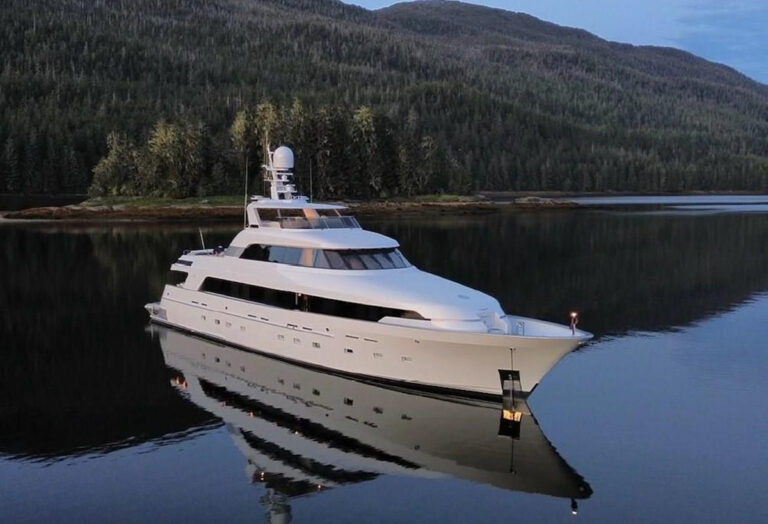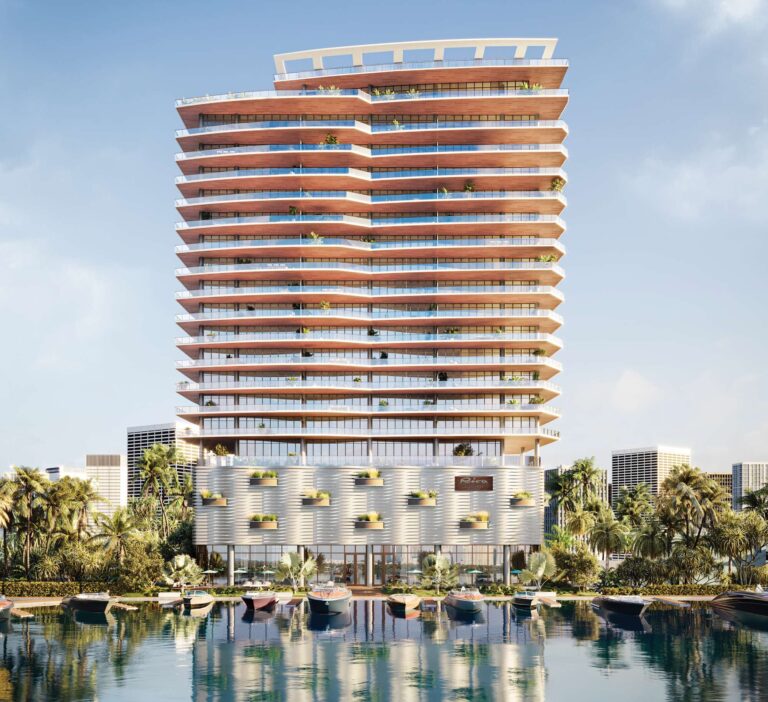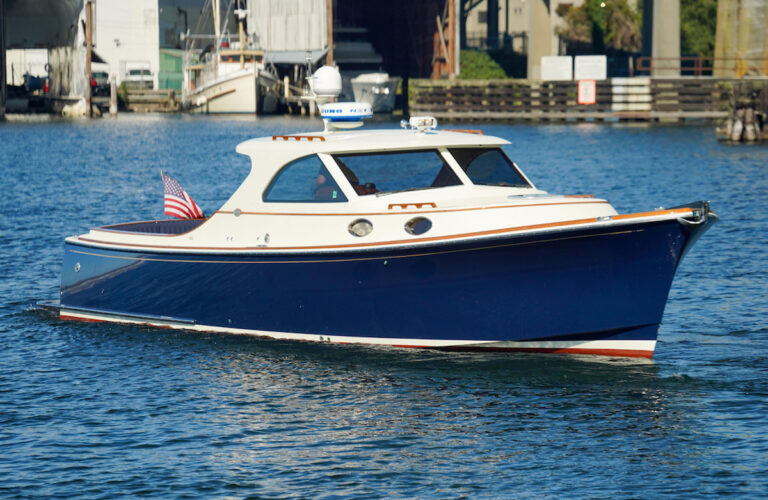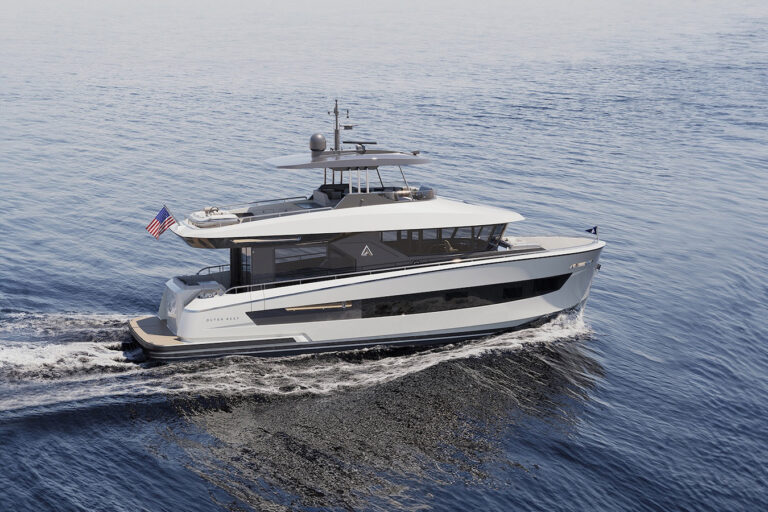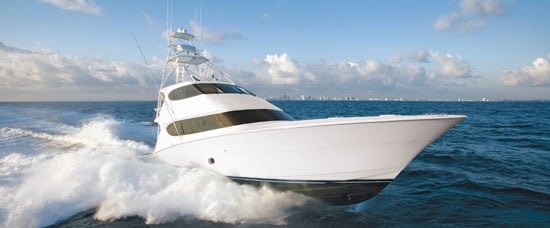
yachting/images/magazine/2007/042007/fea_hatteras1_550x228.jpg
The very first fiberglass boat I fished aboard was a Hatteras. It was early in the 1960s when fiberglass boats were still a novelty. She was a “convertible,” a term Hatteras had coined to suggest her blend of fishing and cruising amenities. Measuring 41 feet, she was one of the largest yachts available in the new material and I confess that, like most dockside pundits, I wondered if the “glass” she was built of would shatter.
This synapse of nautical nostalgia fired as I prepared for a day of fishing aboard Hatteras’ latest creation, the 77 Convertible. I was greeted by marketing director David Ritchie, Capt. Jeff Donahue and mate Kevin Gaylord. As always seems the case when I fish aboard a Hatteras, the wind was howling and conditions were deteriorating-just the sort of weather that inspired Hatteras’ founder, Willis Slane, to produce a breed of tough, capable sea boats. He was one of the first to recognize that fiberglass would be ideal for such an application. Still, I doubt that even Slane would have imagined a boat like the 77.
As is typical during the season, the docks at Pier 66 had a fair share of Ft. Lauderdale’s fleet of large boats. While there were several dozen convertibles in the 60-foot class present, they were dwarfed by the 77. More than a dozen feet of LOA (that’s length overall, class) add significantly to a boat’s proportion. The 77 was hard to miss in the crowd. Hatteras fans will be pleased to note that she incorporates the builder’s latest thinking in styling and there is no doubt as to her pedigree. The dramatic sweep of her sheer accentuates the length of her uncluttered foredeck. Her rakish house and bridge face add an aggressive accent and overall the look is, well, impressive!
On an average day, the 77 would be a bit more boat than you might need to tease sailfish on the edge of the Gulf Stream, but bigger is always better when the seas rise. As the 77 paved a path through Ft. Lauderdale’s Port Everglades inlet, the comfort her size afforded was much appreciated. At the helm the 77 has the stout, solid feel you would expect from a 157,500-pound boat. Hatteras has always believed that mass is an advantage when the going gets rough-and I agree. The trade-off, of course, is that it takes a good bit of horsepower to get things going.
No worries, mate, the 77’s got it. While standard power is a pair of 1,800 hp Caterpillars, I recommend the 2,400 16V-2000 MTUs that were fitted aboard our test boat. This muscle is complemented by a relatively deep 4:1 reduction and 49-inch-diameter wheels that transmit power efficiently to the water. The result is surprising response and agility for a boat her size.
Before we put out our first bait we got down to business and I recorded the 77’s performance running in two directions in what is fair to say were less than ideal conditions. Her 16-cylinder MTUs reached maximum turns (2400 rpm) in a bit less than 30 seconds and I noted a speed of 31.8 knots on the GPS. Capt. Donahue indicated that he routinely sees 34 knots (fully loaded) in more reasonable conditions. As we chatted in the air-conditioned comfort of her enclosed bridge at 26.5 knots (2100 rpm) it was easy to forget that we were running at speed in six- to eight-foot seas. I was tempted to turn toward the Bahamas, and if I had, it would not have been an unpleasant ride. Easing her back to about 22 knots (1800 rpm), the MTU electronics indicated a fuel burn of a bit more than 130 gallons per hour. With the 77’s standard fuel tankage (3,000 gallons) this would allow a range of more than 500 nautical miles.
The machinery space is accessible from the cockpit. There is standing headroom on centerline, and even with the big MTUs there is room to move about. Two 27.5kW Onan generators in sound shields are abaft the engines. Auxiliary systems, including chilled-water air-conditioning and a 1,200-gallon-per-day watermaker, are located forward and outboard of the engines respectively. As is the case on all Hatteras yachts, fuel is carried in UL-approved fiberglass tankage that is built independently of the hull. Excellent wiring and plumbing installations have become a Hatteras standard and the 77’s well-organized systems reflect this tradition.
The 77 features Hatteras’ new hull form, which was first applied in 2002 on the 54 Convertible. Deep, slightly convex sections forward are designed to push the seas aside while spray is turned away by multiple, molded-in chine ledges. Moderate deadrise in her midsection transitions to a deadrise of just a few degrees at the transom. This relatively shallow deadrise aft maximizes lift and together with propeller pockets helps keep the draft a reasonable 5 feet 3 inches. While a steep deadrise is often cited as a solution to ride comfort, this assumes dynamic interaction with the sea’s surface. Hatteras’ approach is to employ deadrise where it will be most useful-forward. This makes sense as given the 77’s length and displacement, her after sections will likely remain engaged with the sea.
With our sea trial complete, it was time to get serious about fishing. Capt. Donahue stepped aft from the enclosed bridge and took his position at the exterior balcony station while Kevin scooped four plump goggle-eyes from the 77’s cavernous 65-inch-long in-sole live well. The Rupp hydraulically actuated outriggers were deployed with a push of a button and with what seemed hardly any effort we had lines wet. Additional tournament outfitting included a lofty Bausch tower and a Pompanette fighting chair with an offset pedestal designed to maximize the chair’s position across the large cockpit. As we were fishing standup style, a rocket launcher/tool drawer was fitted. The bulkhead seating and stowage area has a drink box, bait freezer and tackle storage. An in-sole fish box is plumbed with a macerator and can be fitted with an ice machine. Loitering about at live-bait speed in a slop can bring out the worst in a boat, but the seas slipped past the 77 without causing a fuss.
As was the case with most early fiberglass boatbuilders, the first laminates Hatteras created were designed empirically. Builders would add glass and resin until a panel seemed stiff enough and then add a bit more just to be certain. Later it was learned that achieving stiffness resulted in a solid fiberglass panel that was far stronger than necessary. Addressing this challenge, builders employed lightweight core materials to increase panel thickness and thus stiffness without adding unnecessary weight. Closed-cell foam coring is used on the 77 for this purpose in the bulkheads, the superstructure, the decks and the hull sides above the waterline. Hatteras uses a resin infusion process as well as vacuum bagging to insure that cored laminates are properly bonded. Stitched and woven fiberglass reinforcements are used and exterior surfaces are molded in gelcoat and finished with a two-part polyurethane. The nearly flawless results would be difficult to achieve with gelcoat alone.
Hatteras remains conservative in terms of bottom structure. The 77’s is molded in solid fiberglass and is supported by a network of fiberglass stringers. All exposed bilge areas are finished with a polyurethane coating. Exterior surfaces beneath the waterline are molded with a vinylester skin coat, and an epoxy barrier is applied prior to the bottom paint.
Whether wandering the Bahamas, Mexico or beyond, the 77 will provide a comfortable setting for her owner and guests. A pneumatically actuated door leads from the cockpit to the main cabin, which is arranged conventionally with the saloon area aft and a galley and dining area forward. What is not conventional is the amount of space the 77’s length overall and 22-foot beam afford. An L-shaped seating area with internal tackle stowage is positioned to take advantage of a built-in 50-inch plasma TV. The open galley has a granite service counter with barstool seating. A curved dinette is a few steps away. A day head is convenient to the door leading to the cockpit and the curved cherry stairs that lead above to the enclosed bridge. There is also exterior access to the bridge via the balcony and a ladder from the cockpit. The bridge is arranged with helm and companion seating forward and an L-shaped settee with internal tackle stowage aft. A wet bar has a refrigerator/icemaker and a 37-inch plasma TV, which flips down from the overhead.
Belowdecks the layout has a full-beam master stateroom with a king island berth and three guest staterooms with private heads. A small crew cabin for two forms a buffer between the accommodation space and the machinery space. Access is through the machinery space and there is an emergency exit through the galley. There are several variations to the 77’s arrangement to consider. His-and-hers heads are offered in the master stateroom, but the crew cabin is sacrificed. Owners can also opt between a seating area or an office area in the master stateroom. Hatteras offers customers a variety of woods, finishes and interior accessory packages.
Hatteras has been the leader by measure (in terms of length) in production convertible design and introduced its largest, a 90-footer, in 1995. The 77 now resides neatly between 68- and 86-footers in Hatteras’ convertible lineup. The fact that the builder’s entry-level boat is a 50-footer is a reflection of the direction the market has taken in the last 10 years as fishermen wander farther in search of fish and cruisers find more time to spend away from the dock and office.
In all, the 77 delivers the sort of performance and luxury that attracts the attention of those who are serious about fishing and cruising farther from the dock. In the 1960s the challenge for anglers and cruisers was often simply getting out of the inlet. With this mission in mind a new generation of boats like the 41 Hatteras I remember from my youth were more capable and comfortable than any that had come before. So to for this new generation of Hatteras Convertibles. Indeed, Hatteras’ success is in large part due to the fact that it has not lost sight of the goals that inspired its launch. In this light the old 41 and the new 77 have much in common. Both were conceived with the notion that fishing and cruising can be enjoyed on a single platform in comfort with a minimum of compromise. The 77 Convertible achieves this goal on a grand scale. Willis Slane would be impressed.
Contact: Hatteras Yachts, (252) 634-4895; www.hatterasyachts.com

